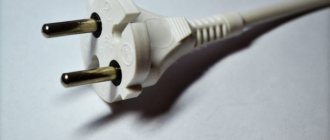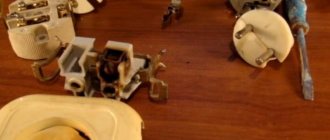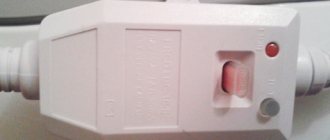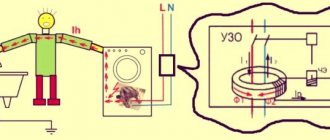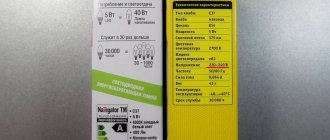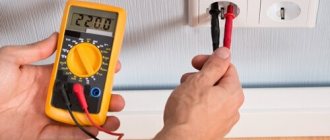Why does the socket spark?
Most often, sparking in a socket is discharges that occur when electric current flows not directly from conductor to conductor, but through a gas, an air gap between the conductors.
The socket sparks due to poor mechanical contact between the conductive parts of the electrical network.
Typically, sockets spark in two cases:
1. If there is a poor connection between the conductors of the input electrical cable and the terminals of the socket mechanism
2. If the contacts of the socket connector are poorly connected to the pins of the electrical plug
As you understand, sparking can occur not only in an electrical outlet; any unreliable connection of conductors can begin to spark. By the way, this is one of the main reasons for the small number of permitted methods for connecting wires in junction boxes during electrical installation.
Loose contact connections
The same effect occurs if it is not the connector contact that loosens, but the wire connection. They may not be tightened enough initially, so they will loosen over time, and an area with transient resistance will appear on them. The further process is similar to that described above, with the only difference being that it takes a longer time. It is believed that contacts need to be tightened periodically. But practice shows that with initially high-quality tightening of copper conductors, they will never need to be pulled. But aluminum wires need to be tightened, since they are softer and tend to gradually deform under the action of the mounting screws. Another property of aluminum affects the heating of contacts: when bent, the wire breaks. An inexperienced electrician may not notice this; the wire looks intact, but in some place it is enough to bend it a little for it to break completely. Heating also begins at this point and is transferred to nearby metal parts. As a result, the wire sparks and burns out. That is why the installation of new electrical wiring in residential premises using cables with aluminum conductors is now prohibited.
What to do to avoid breakdown
You can prevent a malfunction by fulfilling the following conditions:
- When using a switching connection in the form of a plug connector, use the same type of connection elements; use the socket only for its intended purpose and in accordance with the operating rules.
- If the product is made of poor quality materials, it must be replaced.
- Use tested devices that have certificates of conformity. Purchase in specialized stores, not in markets.
- If the electrical strength of the insulation of wires and cables is low, replace them with new ones that meet the requirements for electrical wiring. The need for replacement is determined during preventive tests or when emergency situations occur in electrical networks.
- If the screw connection of the wires with the contacts is loosened, they must be tightened. When using clamps (spring mechanism) in a specific model, the correct solution is to replace the product with a new one equipped with screw clamps.
- Use devices and devices that correspond to the rated current of the installed plug connection. The rated current value is displayed on the socket body, and on devices - in the passport and on structural elements (housing, inventory plate, tag, etc.).
- If carbon deposits appear on the contacts, you need to thoroughly wipe the connection points with a rag moistened with solvent.
- If the connected device has a toggle switch or an “On/Off” button, always use them, and not just pull the plug of the working device from the socket.
- In wet rooms, use only sockets with an appropriate level of protection.
- Install a circuit breaker on the line of outlet groups that matches the wiring capabilities.
This is interesting: How to find a short circuit in the wiring of a house or apartment: we reveal the essence
Precautionary rules and tool kit
The electricity needs to be turned off. You need to unscrew the plugs or block the machines on the dashboard. Work is carried out using special gloves. They are called dielectric. Gloves are made of latex or rubber and prevent current from entering the skin.
Residents must be warned about the work being carried out. Otherwise, someone might turn on the electricity.
Tools to repair the socket will require:
- straight screwdriver
- crosshead screwdriver
- pliers
- wire cutters
- multimeter
- insulating tape
- cable cutter
It is important that the handles of the tools are securely insulated. Sometimes a file and sandpaper are also required
It’s worth stocking up on them just in case.
How to fix the problem
If the sockets spark, you need to call an electrician or try to fix the problem yourself. First of all, turn off the power to the panel and warn the apartment residents about the repair. To inspect the contact part, you will need to remove the front panel.
Worn wiring can cause sparks to form in the outlet.
Procedure:
- Check the condition of the wires; oxidation on the copper must be cleaned with sandpaper.
- Tighten the screw terminals with a screwdriver and bend the contact plates.
- Inspect the wiring; if there are exposed areas, cover them with insulating tape.
- Secure the structure with the set screws located on the sides.
You can check the quality of the repaired structure by inserting a plug. A tight crimp of the pins indicates that the main problems have been eliminated. After the electricity supply is restored, the point is checked by turning on a medium-power appliance, such as an iron. If the result is satisfactory, it is recommended to periodically monitor the condition of the plug connector.
If the contacts and plastic are blackened and charred, it is better to replace the socket. If the standards do not meet, you will have to buy a modern electrical installation product of a suitable type. It will ensure normal use of household appliance plugs.
If the socket cracks during operation
If a cracking sound is heard when the plug is in the socket, then this is already a sign of poor contact in some part of the electrical circuit. Often, over time, the surface of the plug or the socket itself heats up, or even all at once.
Causes of crackling noise in a working outlet
In fact, a working socket makes noise for the same reason as when inserting a plug - the contacts do not touch closely, and in some places they do not reach each other. The consequences are standard: their surface oxidizes, resistance to electric current increases and the metals begin to heat up.
In the same way, a socket cracks if the bolted connections are loosened - the wire inside the contact begins to move and protrusions form, between which sparks appear. The socket begins to make noise, and if the contact is very bad, it can heat up and melt.
Also, the cause of sparking may be a mismatch in the diameter of the pins of the plug and the contacts of the socket; a typical example is when an old Soviet plug is inserted into a modern Euro socket.
Euro plug on the left, Soviet plug with smaller diameter pins on the right
Watch the details in this video:
The fourth common reason why an outlet gets hot is a mismatch between the power of the devices connected to it and the throughput of the wires. If you rub something against each other, both of these things will heat up, and the electrons inside the conductor “run” at the speed of light. As a result, if the wiring periodically operates at the limit of its capacity, then it warms up.
This is not critical for the cores themselves, but the insulation, which constantly softens and hardens, loses its properties over time. It is also necessary to take into account the ability of electric current to straighten the wiring through which it is passed. When a powerful device is turned on through a weak conductor, the heating core heats up the insulation, which becomes soft and is “picked apart” by the wire trying to straighten out. Ordinary vibration, which appears in devices powered by electric current, can also have its say. It may not be noticeable to the naked eye, but such wiring does not always short out immediately. Over time, the core may come out of the insulation and then, at best, there will be a sparking contact, and at worst, it will lead to a short circuit.
Elimination methods
Usually, when sparking occurs, it is enough to sort through the sockets - if you take them apart, then what to do next is usually visible to the naked eye. The place with poor contact is marked with scale from the melting of the insulation, and the insulation itself is hardened and brittle. If there is little carbon deposits, you can simply clean it off and tighten the bolted joints. When it comes to serious melting of the insulation of the wires or the socket body, it is strongly recommended to replace them.
Selection of sockets, plugs and tees
The reason for the incorrect operation of the socket may also be the poor quality of both the socket itself and the plug of the electrical appliance; this problem is discussed in detail in the following video:
Causes of sparks in an outlet
A blown electrical outlet may cause a fire or seriously damage the plug.
The purpose of the plug socket is to connect the plug with the electrical network. During normal operation, current flows through the contacts with minimal heat generation. In some cases, when inserting a plug into a socket, a breakdown occurs. The higher the power of the device being turned on, the more intense the sparking and crackling. The temperature of the electric arc is very high, and a characteristic smell of molten plastic appears.
Sockets crack for several reasons:
- Exceeding the power for which the electrical installation product is designed.
- Long service life and natural wear of connectors.
- Loosening of contact clamps.
- The plug connection parts are manufactured to different standards.
- The product supplied was of low quality and had a short service life.
If the socket shorts out when you turn on electrical appliances, you should temporarily use another power point. There are several factors leading to failure.
Overcurrent
Like any electrical connector, a plug socket has its own characteristics that determine the permissible connection parameters. Simply put, if the permissible current of 16.0 A is indicated on the installation electrical device, then it is allowed to include electrical appliances with a total power of no more than 3.50 kW. How to calculate the permissible power from the rated current will be discussed separately.
Indication of the rated current on the socket body
Those who do not want to bother themselves with calculations can use the table below.
Table 1. Correspondence of the rated current of the socket to its power.
| Rated current parameters (A) | Rated power (W) |
| 6,0 | 1300,0 |
| 10,0 | 2200,0 |
| 16,0 | 3500,0 |
| 32,0 | 7000,0 |
If the permissible load is exceeded, the contacts of the socket connectors will begin to heat up. This leads to the fact that the conductors connected at the connection points begin to gradually burn, increasing the contact resistance, causing even greater heating and sparking. That is why it is not recommended to repeatedly connect electrical appliances through a tee or splitter. If this becomes necessary, it is better to install double sockets.
How to calculate the power of an outlet?
To do this, use Ohm's law for an alternating current circuit. In our case, the formula will have the following form: P = I*U*cos φ, where:
- P is the required permissible load power;
- I – permissible rated current value (indicated on the socket or in the technical documentation for it);
- U – voltage of the electrical network, at home – 220.0 V;
- cos φ – the value of the power factor; if it is not indicated on the electrical appliance connected to the outlet, then we take the value 0.95.
Let's give an example of a calculation. Let's say we have a 16 A socket, which means the permissible load power on it will be equal to 3344.0 W (16 x 220 x 0.95). As you can see, the calculated value is slightly less than the value in Table 1. That is why it is not recommended to load the outlet to the maximum. There is another reason to avoid maximum loads, which will be discussed further.
Worn wiring
The next reason for an outlet to fail is the deterioration of the electrical wiring in the house (or apartment).
If the diameter of the cores is small, then you should not connect powerful electrical appliances (for example, a microwave), otherwise the line will simply not withstand the current load, as a result of which the outlet will begin to spark. Here you need to first inspect the old current-carrying line and, if necessary, replace the electrical wiring in the house. Correct replacement is carried out based on calculation of the cable cross-section for power and current.
How to eliminate sparking in an outlet?
Having dealt with the reasons, let's move on to ways to eliminate each of them. Let's start in the same order:
- Mismatch between plugs and sockets can be easily resolved. It is necessary to bring them to a single type. We recommend choosing modern standards, otherwise you will need to change the plugs on each newly purchased electrical appliance. That is, we are replacing Soviet sockets with European standards. In addition, if the house has vintage electrical equipment, we replace the old plugs on it.
- To eliminate an outlet overload, you can go in several ways:
- Replace the electrical installation device with a more powerful one. For example, if the outlets are rated at 10.0 A, then replace them with 16.0 A products.
- If one outlet is not enough, then install an outlet block. This will be much more reliable than using a tee. If for some reason there are difficulties with installing the socket block, use a double socket installed on one seat. Double socket
- You can try to repair a worn plug connector if the case is not very advanced. To do this, you need to remove the socket (after de-energizing the line from which it is powered), clean it, and then bend the contact plates using duckbills (thin pliers). If the socket cannot be repaired, we replace it.
Remember that frequent plugging will shorten the life of the plug connector.
- If the clamps are loose, tighten the contacts (after turning off the power). For copper wiring, it is recommended to repeat this procedure every 5-10 years; for aluminum wires, not once every two years. If possible, replace the wiring with copper.
- Do not purchase low quality products. Savings in this case are somewhat inappropriate. It is not too difficult to distinguish a counterfeit from an original; first of all, it is a suspiciously low price and the lack of certificates for products. This product is also characterized by low quality plastic housing, lack of packaging, and incomplete packaging.
The socket is sparking - how to fix it?
Once you have determined why the outlet is sparking, you can begin to fix the problem. Well, if everything is clear with the last point about purchasing only high-quality products, then we will now consider solving the remaining problems.
- To solve the problem of non-compliant sockets and plugs, you will have to spend a little money. You need to replace the old models with Euro standard models. It’s not that much money, but you’ll forget about the sparking of the socket for a long time.
- In order not to overload one outlet, I recommend installing a block of sockets. It’s better to install 2 or 3 than to connect a bunch of extension cords or surge protectors. It would also be advisable to replace the weak version with a more powerful one. So if you have a 10 A socket installed, and there is a significant load on it, then it is better to install it at 16 A or 32 A.
Did you know that you won't miss any of our content if you subscribe? Subscribing is easy: just enter your email in the form below this article and click on the “Subscribe to newsletter” button. And you will always be aware of our publications!
I hope my article today was clear and useful. Now you know why the socket sparks when you insert a plug, and how to fix it. Write in the comments if you have encountered such a problem?
Socket sparks: possible reasons
Next, remove the wires from the outlet. Now, you can prepare a new socket, or use the old one. The wires are cleaned to a shine, as are the contacts in the socket. Now the stripped wires are attached to the socket; tighten the bolts holding the wires well. Also check that the plug is not loose in the socket, since due to poor contact between the plug and the socket, the socket may become heated again and one of the contacts may begin to melt.
Perhaps this is due to contacts that have “moved away”, so to speak. Therefore, proceed in the following way: de-energize the outlet (turn off the circuit breaker through which power is supplied to it), unscrew the cover of the outlet and, if necessary, pull out the “body” of the outlet itself from the wall, tighten the bolts that hold the wire. This way you tighten up your contacts. Look carefully to see if there is a break in the wire. And one more thing: keep in mind that if there is even the slightest trace of burning on the outlet itself, it is better to replace it with a new one.
The socket sparks. For what reasons? How to fix?
- Cleaning and freeing contacts from traces of oxidation and burns, if any. This applies to the contacts to which the plug is connected;
- Checking the quality of the connection of the power wire to the terminals of the contact group. If the clamp is bad, carbon deposits have appeared there or they have become too oxidized, then they should be cleaned;
- If the cause of the crackling sound is wear and tear on the wiring itself, you should stop using the outlet until the current-carrying cable is completely replaced;
- If you have installed a product of poor quality, or as a result of heating and constant sparking, the socket has received severe damage to the contacts or clamps with the contact group, then you should completely replace it with a new, good quality one, designed for the load that you expect for this power supply point.
Crackling noise when plugged in
This phenomenon is observed quite often - for example, if you leave home for several days and unplug electrical appliances from the outlets. Upon returning, everything turns back on and then a noticeable flash is visible in some sockets and a loud crack is heard.
Causes
Despite the fact that this all looks quite threatening and causes many to reflexively pull their hands away from the sockets, there is nothing in this phenomenon that indicates a malfunction. It’s just that when the contacts of the plug approach the contacts of the socket, an electric arc jumps between them an instant before contact. This is the nature of electric current and the higher the voltage at the contacts, the greater the distance such an arc can stretch.
In industrial conditions, special arc-extinguishing chambers are made near the contacts of starting devices, and in particularly powerful devices, devices are even used to extinguish the arc with compressed air or another method.
What’s interesting is that reflexively withdrawing your hand from such an outlet is completely meaningless. And not because this phenomenon is not dangerous, but because of deception of vision and hearing due to the imperfection of these sense organs. The fact is that the microlightning that occurs when contacts touch lasts a hundredth, if not a thousandth, of a second. Given that the human eye perceives everything at a speed of 24 frames per second, it only sees the original image captured on the retina and gradually fades away. It’s the same with sound - an audible crack is thunder in miniature - first the primary disturbances of the air reach the ear, and then the consequences of displacements of its molecules.
What can be done
It would seem that the issue has been resolved and now you can simply not be afraid of this phenomenon, if not for one “but” - not every socket sparks... This is even more surprising if all the installed sockets are the same, which means that this behavior cannot be explained by differences in design.
The reason is simple - plugs from switched-off devices are inserted into some sockets, and plugs from switched-on devices are inserted into others, on the contrary. Take a computer for example - usually all its peripherals are connected to one surge protector with 5-6 outlets. This is the system unit itself, a monitor (or even two), speakers, a printer, a router - maybe something else is connected. When the computer is turned off, in fact, it is not completely de-energized - all its components are in standby mode, so if you unplug the surge protector from the socket, it will “remember” its last state. Accordingly, when the plug is inserted into the socket again, all devices will simultaneously “fucking” the electric current, which will cause a discharge in the socket.
This will not happen if, before leaving, you turn off the power to each device separately - manually turn off the monitors, turn the switch on the power supply of the system unit, flip the toggle switch on the speakers and the printer. Then, when the plug is plugged into the socket, the circuit will not close and there will be no discharge.
How does this affect the outlet?
Theoretically, when even microlightning occurs, the surface of the contacts burns and may become unusable over time - the resulting soot will cover everything with a film with high resistance, this place will begin to heat up and the socket may begin to melt.
In practice, the discharge hits the tip of the plug and the very beginning of the socket contact - when the plug is fully inserted, the working surface of the contacts is completely different. Moreover, if the plug is not taken out of the socket often, then the contact is very far from being damaged.
As a result, when the socket sparks when you turn on the plug, you need to realize that everything has already happened and simply insert the plug further.
Why does the socket spark?
First of all, you need to be well aware of the conditions under which a spark can form. From a physical point of view, each such spark is a kind of electric arc in the form of an ionized gas section through which electric current flows. Unlike metal conductors, where the current moves imperceptibly to the eye, a luminous flux is formed in a gaseous environment during the movement of charged particles.
Exactly the same situation occurs at the moment of contact between a plug and a socket that have a potential difference. At this point, enough electrons are produced to create a current that causes breakdown. The intensity of sparking depends on the network voltage and the power of the connected devices. The higher these parameters, the more noticeable the sparks will be at the electrical contact points.
The appearance of sparks in an outlet can occur for several reasons. One of them is the presence of a certain resistance value on the power cord or in the electronic circuit included with the design of the device. If there is a capacitor at the input of the circuit, the sparking effect increases even more. In this case, there may be no power button at all, or it may be turned on even before the device is connected to the outlet. Therefore, even the highest quality socket will spark at the moment of contact with the plug. To avoid this, it is recommended to use a switch installed on the device itself.
Another common cause of sparking is the incompatibility of old plugs installed on household appliances and new sockets manufactured according to European standards. The contact parts of old plugs have a smaller diameter compared to the female contacts of new sockets. This mismatch leads to loose fitting of the plugs in the sockets, and contact between them is only partially achieved. In fact, there is a constant interruption of electrical contact between the conductors. As a result, such intermittent contact causes constant sparking and subsequent complete failure of even the highest quality socket. Therefore, during operation it is recommended to use products of a single standard.
Often old sockets completely exhaust their service life and are in a worn-out condition. The crimp contacts are coated with a layer of carbon deposits, which creates additional resistance. Therefore, when turned on, the plug first touches the carbon deposit, which leads not only to poor contact, but also to sparking. The contact jaws themselves may become loose, causing a decrease in their crimping ability and the occurrence of sparks. The best solution to the problem would be to replace the socket, but if this is not possible, you should carefully tighten and clean the contacts of the old product.
Sparking sockets also occur as a result of an overloaded electrical network. As already noted, as the power of consumers increases, the spark at the contact points also increases. For example, if several powerful devices are connected to an extension cord simultaneously, then all this power is summed up, and the entire load falls on the outlet into which this extension cord is plugged in. At the moment such a total load is connected, a very strong spark appears in the outlet. With regular use in overload mode, any socket will fail, despite its high quality and technical characteristics. Therefore, it is better not to remove the plug from the socket unless necessary, and to turn on the devices either with their own buttons or with a general switch located on the body of the extension cord.
The main reasons why an outlet sparks
Any device wears out after a certain time. Individual parts are unscrewed or loosened. This leads to poor contact of the electrodes with the electrical network. Let's look at the main reasons why sparking occurs when electrical appliances are turned on.
Plug doesn't fit
In some houses, electrical fittings have been installed and have not been changed since the construction of the house - almost since Soviet times, or since the last renovation, which was done 15-20 years ago. Electrical sockets were then produced for electrodes with a diameter of 4 mm. Most modern forks have a diameter of 4.8 mm, so they do not match each other in parameters. When electrodes with a smaller diameter are turned on, insufficient contact is obtained, which is why sparks appear.
In modern life there are still many household appliances in which the diameter of the electrodes on the plug is 4 mm - from chargers for smartphones to TVs.
Electrical overload
Another common reason why a socket sparks when you insert a plug is that the rated electric current load is exceeded. All devices are designed for a certain current in the network. If the total power of electrical appliances exceeds it, sparking occurs. When purchasing, you need to pay attention to the labeling of electrical accessories.
If you plan to connect several devices at once, it is better to initially choose good quality electrical fittings that can withstand loads for a long time that are close in value to the maximum threshold standards.
Exceeding the maximum permissible values leads to overheating of the contacts. As a result, they burn out, resistance increases, and sparks appear when turned on.
Connector wear
The weak element in the design of the plug connector is the contact clamps. Over time, they weaken and no longer fix the plug electrodes with sufficient force. The connectors wear out, the reliability of the electrical contact decreases, which leads to the appearance of sparks.
From the experience of the masters. This type of malfunction occurs not only in electrical outlets that have been in use for a long time. If you frequently plug and unplug electrical appliances, the plug connectors will wear out faster.
Loosening screw terminals
If the socket sparks, the screws may be loose. This results in insufficient contact. The wire connections become hot and cause sparking. This is especially true for old electrical wiring that was installed with a cable with aluminum wires. The aluminum alloy begins to leak over time, causing the electrical contact of the clamp to weaken.
Poor quality electrical outlet
Saving money on electrical fittings and wiring is not recommended, as the consequences can be serious. In a competitive environment, some manufacturers reduce the cost of their products by reducing quality. It is best to buy electrical goods from trusted manufacturers who have proven themselves to be the best.
Why are the sockets humming, what should I do?
If the socket makes sounds (noise) or buzzes... This means there is poor contact between the wire supplying the socket and the plug that is plugged into the socket. Note that noise appears when a load is connected. There is no noise without load. We turn off the power to the outlet. Turn off the circuit breaker. We disassemble the socket. We remove the cover and visually see if the contacts are burnt or not. Maybe the fork clamps became more loose than they should have been. The result is poor contact between the plug and the socket. The fork may also get hot. The next possibility is that the contacts between the wire and the terminal blocks of the socket are burnt. The wire may also be oxidized or burnt. Due to this, the diameter of the cores became smaller and the load in this place increased. We unscrew the terminal blocks, pull out the wire from them, strip it or trim it, bite off the old burnt one and strip the insulation from the new one. We clean the terminal blocks from burning or traces of oxidation or replace the socket with a new one.
Most likely there is one reason: the wire contacts were loose or loosened as a result of use. Because of this, the contacts become charred and begin to heat up and hum. Here's what needs to be done: You need to turn off the power in the house/apartment. Open the socket cover. Then unscrew the socket itself from the wall.
Causes of sparking sockets.
Sparking occurs if the plug and socket are of different standards.
Not everyone knows that in Russia and the CIS countries two standards of plugs and sockets are used: Soviet (C) and Schuko. The Soviet standard has become obsolete and is now practically not used. The plugs and sockets of these standards have different designs, but externally they differ only in the diameter of the plug electrode. The Soviet plug has an electrode diameter of 4 mm, while the Schuko plug, which is now installed on most household and industrial appliances, as well as power tools, has a diameter of 4.8 mm. But both standards have the same distance between the electrodes, which allows them to be combined with varying success, because the difference of 0.8 mm is practically invisible to the eye.
It’s easier to forcefully insert a Schuko plug into a Soviet socket, or even bore holes in it, than to remember all these standards. And, if in this case, the electrical contact is reliable, then the reverse combination can bring problems and terrifying consequences. When installing a Soviet standard plug into a Schuko socket, due to the difference in the diameter of the electrode and the socket of the socket, sparking will certainly appear at the contact point, even under the lightest load. Depending on the load, as well as over time, sparking will cause the body of the plug and socket to melt.
If you are unlucky and you notice late that the plug and socket do not match, they are already ruined, then you can simply replace them. But to prevent this from happening, always make sure that the socket and plug are of the same standard.
What to do if the socket sparks
The main cause of sparking in sockets is poor-quality broken contact between conductors. Due to the loose fit, electricity enters the air, resulting in a spark gap. A kind of small lightning appears in it, which is considered an electric spark.
Socket repair:
Before you begin repairing the outlet, you must turn off the power supply and make sure there is no voltage. To gain access to the functional module, you must first remove the decorative cover. First, the condition of the wires secured in the clamps is checked. They should not be broken, burnt, oxidized or covered with soot.
You should pay attention to the presence of scale on the contact plates and mounting bolts, since oxidation reduces the spring properties. High-quality products are additionally equipped with springs that press the contact petals. Carbon deposits are removed from the ends of wires and contacts without the use of sandpaper
When tightening the contact clamps, force must be applied. Burnt-out wiring is freed from insulation. After inspection and elimination of deficiencies, the decorative overlay is installed in place, and electricity is supplied to the network. A table lamp or some other low-power device equipped with a power button is connected to the outlet. During the check, you need to pay attention to the pins of the plug, which must fit very tightly into the sockets and contacts of the socket with force. This will prevent sparking due to the mismatch of these products with each other. If the sockets are connected to the installation box using a cable, it is recommended to provide for the laying of two phase and two neutral ends in advance. Many modern sockets are additionally equipped with a grounding contact. If there are no visible faults, you can connect something more powerful, for example, a vacuum cleaner or iron. If after switching on there is no sparking or heating, then the socket repair was carried out correctly. It is recommended to monitor the operation of the outlet for a certain time with the electrical appliance turned on.
If all of the above measures do not produce positive results, it is necessary to completely remove the working part of the socket from the installation box and conduct a more thorough visual inspection for damage to any other elements. Loose contact sockets are tightened with pliers, and clamping bolts with damaged threads are replaced with new ones. If restoration and repair are impossible, the working module must be replaced completely.
Timely prevention is of great importance. Many homes still use aluminum wires to carry electricity to electrical outlets. Since aluminum is a very soft metal, you should regularly tighten the connections between the wires and the contacts. It is recommended to select the sockets themselves in accordance with the maximum current, the value of which is marked on its body.
All household appliances are equipped with power buttons, regulators or toggle switches. With their help, the device itself must first be turned off, and only then the plug is removed from the socket. Before connecting, on the contrary, all devices must be turned off.
If an outlet in the house sparks when connecting or disconnecting household electrical appliances, it is necessary to take urgent measures to eliminate the malfunction. In practice, this problem becomes a frequent cause of fires. Let's figure out what causes the sparking of the electrical contact in the plug connector and, depending on the cause, we will choose the optimal repair method.
2. Sparking occurs due to overcurrent.
This is one of the most common reasons why sockets fail. The rated current of the outlet is usually written on its body. But not all ordinary people understand these numbers; for most, all these amperes look like the cuneiform writing of the ancient Sumerians. And in order to correlate the power of connected electrical appliances with the rated current of the outlet, there is no need to talk about this. How to do electrical wiring yourself.
For this reason, several powerful electrical consumers are often connected to one outlet (which is why it is dangerous to use tees and extension cords), because of which the current in the outlet can exceed the rated one several times, especially with a weak outlet. In this case, the contacts heat up, their resistance increases, due to which they heat up even more. This vicious cycle leads to sparks, flames, melted sockets and plugs, and ultimately a fire.
This situation can be avoided by not overloading the sockets. To give you an idea, let’s give the maximum power that sockets can provide for each ampere of rated current: 220 W. This means that for a 16 amp outlet the maximum power will be about 3.5 kW. Just don’t think that if an outlet has two connectors, then it is twice as powerful as a single one. Its rating is common to all plug connectors and, accordingly, is distributed among all consumers according to their power consumption. If the socket sparks due to overload, then its internal contacts have already been broken and must be replaced.
Disadvantages of electrical wiring
The daisy chain connection of sockets brings many problems for consumers. This is when the cable from the panel or junction box goes to one outlet, from it to the next, and so on. The cable cores are connected under one screw. With this scheme, the total current of all electrical appliances connected to the loop flows through the first contact connection. But the connection itself is also designed for the rated current of the outlet. This is why even under a light load the plug in the socket sparks and melts: it is heated by the currents of electrical appliances connected to neighboring sockets. You can eliminate the loop by redoing the electrical wiring. All wire connections must be made in junction boxes, with a personal cable laid to each outlet. Perhaps these are all the reasons why sometimes the socket sparks when you insert a plug into it. Knowing the answer to this question will allow you to protect yourself from such an unpleasant and dangerous effect.
Inconsistency of plug and socket standards
In Russia two standards are used:
- type “C” or “Europlug”
: plug with two round pins with a diameter of 4 mm. Soviet-style plugs, still in use today, had the same pin diameter. - type "F" or "Schuko"
: plug with 4.8 mm diameter pins and ground pin. It is mistakenly called a "Europlug", although this term is a translation of the word "europlug".
If the socket is designed for type “C” plugs, then connecting type “D” to it leads to loosening of the contacts and increasing the gaps between them. Further use of plug “C” leads to insufficient crimping of its contact blades and sparking. Using "C" with "D" sockets, especially when drawing high current, produces the same results, since the contact system is not designed to crimp smaller diameter pins. Although manufacturers are trying to make the contacts universal, realizing that a socket with a grounding contact will not always be used only for connecting Schuko plugs.
Socket sparks when plug is plugged in
From time to time, many people experience a situation when, when connecting or disconnecting electrical appliances, a cracking sound appears in the outlet, as well as sparking, visible even from the outside. In some cases, there is an unpleasant smell of burnt plastic. A characteristic sign of a malfunction is considered to be noticeable heating of the plug, as well as one or both contacts of the socket itself.
The reasons for this condition may be different, but the main one is considered to be the already noted discrepancy between plugs and sockets according to established standards. There are currently two standard plugs in use:
- Type "C" has two round pins with a diameter of 4 mm. They are also called “Europlug” and correspond to Soviet models that are still used today.
- The "F" type plug has pins that are 4.8mm in diameter. In addition, it additionally has a grounding contact. It is known as "Schuko".
If you connect a type “F” plug to a socket designed for “C” plugs, this will cause the contacts to gradually loosen, and the gaps between them will increase significantly. When plug “C” is then used again, the loose contact blades do not compress the pins sufficiently, resulting in sparking.
The same situation arises when using “C” plugs with sockets designed for the larger pin diameter of “F” plugs. Here, too, due to weak crimping and contact, sparks appear, which contribute to premature wear of the products.
Possible consequences
For those who are delaying the repair of a sparking socket, we recommend that you read this section carefully and then begin immediate repairs.
Without eliminating the cause of the sparking, the home master puts himself and everyone who lives with him at risk. A problem plug can cause a fire in your home. Sometimes a weak spark is enough for a fire to engulf a home.
The plastic of high-quality products is not subject to combustion, but this does not mean that it will not melt and if you try to pull out the plug, you may be exposed to the harmful effects of electric current.
You should not blindly rely on the operation of circuit breakers, especially if they were installed 5-10 years ago and were not checked after that. Connecting a high-power device or extension cord with equipment connected to it may cause the wiring to catch fire due to overload, and the AV may become faulty. In practice, such cases are not uncommon; it is especially surprising when a plug is inserted into a sparking connector, since it is located very conveniently.
To repair an outlet or replace it, it will take no more than 10-20 minutes, a maximum of twice as long if you lack the skills. But with a reliable electrical contact, the danger will no longer threaten your home.
Consequences of sparking
If measures are not taken in time to eliminate sparking in an electrical outlet, the consequences can be serious. First, the plastic case begins to melt, and the contacts gradually burn. If you try to pull out the plug, the plastic may become exposed to electric current. Sometimes a small spark is enough to start a fire that can quickly engulf the entire house. Therefore, you need to know what to do if the socket sparks when you insert a plug.
Even if automatic switches are installed in an apartment or house, this does not provide a complete guarantee that a fire will not occur. It happens that their performance is not checked for years. Turning on powerful devices can cause a network overload, due to which the wiring will catch fire and the machine will become faulty.
The plug and body get hot
This symptom indicates that significant transient resistance has arisen at the connection point. This happens, as a rule, for the following reason. At one time, when the contact weakened, no repairs were made.
Over time, in the place of poor connection, under the regular influence of a small electric arc (accompanied by crackling), carbon deposits grow, which, being a poor conductor, heats up greatly when electric current passes through it.
Having opened the cover, you can make sure that the threads of the screws of the clamping terminals are burnt and the screws are “stuck”, and the copper contact plates have greatly changed color and, naturally, have lost their elasticity. In this case, it is impossible to repair them yourself.
If heating attracted attention earlier, the device can be repaired by cleaning the parts from slight carbon deposits and stretching the contacts
Screw clamps are loose
Any dismountable product tends to wear out over time. All screws, latches, springs are unscrewed and weakened over the entire period of operation. The result of this, again, is poor contact of the electrodes with the network, as a result of which you can see how the socket sparks on its own (without plugging in the plug).
If the wiring consists of aluminum conductors, then the screw terminals need to be tightened several times a year, because aluminum tends to “leak”, as a result of which the contact weakens, from which it begins to spark. The connectors themselves where the plug is inserted may also be worn out. The plug is fixed using special clamping jaws, which unbend when frequently connected/disconnected. In this case, you need to bend them inward with pliers.
These two reasons are the most popular, and if sparking is detected in time, the situation can be saved by ordinary repairs. If you have already disassembled the outlet, carefully examine all other elements of the structure: perhaps intervention will be required somewhere else.
Video instructions for repairing an outlet that sparks
Loosening screw terminals
If, when installing the internal mechanism of the socket with a screw clamp, the supply wire was not secured well enough, this can quickly lead to sparking and crackling in the socket. This is one of the worst possible failure scenarios, as the stress applied when you insert the plug begins to further destroy the already poor connection.
Such problems can cause the outlet to start sparking even when you are not using it. This is very dangerous from a fire point of view, because a short circuit can occur at any time. This is one of the most common causes of fire due to faulty electrical wiring.
Low product quality and wear and tear
The cost of installation products from different manufacturers varies over a wide range. Each product occupies its own price niche: not every buyer is ready to spend money on an expensive socket, switch, plug or lamp. It happens that even well-promoted brands do not meet the expectations of customers: each has its own advantages and disadvantages, and the contact system of sockets is no exception. Particularly influential is the fact that the contacts of the plug connector are structurally made in one piece with the contact for connecting the supply conductor. When you tighten it, you can deform the connector; the plug will come into contact with it not with the entire plane, but with part of it. At small loads this will not be noticeable, but at high currents heating of the contact is inevitable.
The socket connector must withstand repeated plug connections, as well as its long-term presence in it without changing its properties. In practice, the contacts of a low-quality plug are made of cheaper materials, the springing properties of which are lost much faster than those of more expensive products. This is why sockets spark when a plug is inserted - a loose contact system, when the pins move in it, periodically loses connection with them. During operation, heat will be released in the place where the contact is loosened, and a heating element that is harmful to it will appear in the outlet. When heated, surfaces become covered with an oxide film, which further increases the contact resistance and increases the temperature. The process inevitably ends with the heated part melting the plastic around itself, it flows inside the connector and sometimes even blocks the plug in it. The plug itself also heats up, sparks, and the hole around it melts. It is no longer possible to use such a product, and sometimes it is not possible.
Electrical and mechanical overload
The majority of commercially available sockets and plugs are designed for a current of 16 A. Copper and aluminum cables with a cross-section of 2.5 mm2, used to connect to a household network, can easily withstand it. Soviet-style plugs were designed for a current of 6 A, which limits their use. In addition, they do not have a grounding contact; they cannot be used to connect consumers with a protective conductor. Exceeding the rated currents leads to sockets sparking, overheating, and failure. Of course, it is difficult to imagine that it is possible to connect a single load with a power exceeding 3.5 kW. But there are other ways that lead to a similar result. This is the use of extension cords and splitters. Extension cords also have their own rated currents. This applies to sockets installed in them, plugs and connecting wires. If several heating devices are connected to the extension cord and the total load current exceeds the maximum permissible, not only the socket sparks and heats up, but also the plug, as well as the connecting wires. This can damage the outlet and start a fire.
Distributors (for example, tees), in addition to the fact that they also have a permissible current of the contact system, which should not be exceeded, also exert a mechanical load on the socket. Several plugs with wires and the weight of the tee itself pull it down, slightly bending the pins of the plug in the contact system, ultimately worsening the contact. Therefore, if you have many electrical appliances that need to be connected to the network in one room, it is better to install additional sockets in places where they will be more convenient to use. The use of extensions and tees should be avoided as much as possible. Sometimes the problem is solved by installing a double socket, if the total current of household appliances connected to it does not exceed 16 A.
